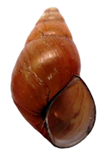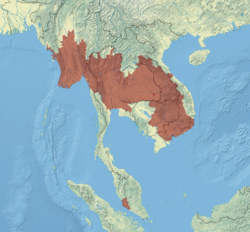Biology:Bithynia siamensis
| Bithynia siamensis | |
|---|---|

| |
| Apertural view of the shell of Bithynia siamensis siamensis | |
| Scientific classification | |
| Domain: | Eukaryota |
| Kingdom: | Animalia |
| Phylum: | Mollusca |
| Class: | Gastropoda |
| Subclass: | Caenogastropoda |
| Order: | Littorinimorpha |
| Superfamily: | [[Biology:|Rissooidea]] |
| Family: | Bithyniidae |
| Genus: | Bithynia |
| Species: | B. siamensis
|
| Binomial name | |
| Bithynia siamensis Lea, 1856
| |
Bithynia siamensis is a species of a freshwater snail with a gill and an operculum, an aquatic prosobranch gastropod mollusk in the family Bithyniidae.

Subspecies
WHO (1995)[2] recognized the following subspecies:
- Bithynia siamensis siamensis - synonym: Bithynia siamensis goniomphalus[2]
- Bithynia siamensis funiculata[2]
- Bithynia siamensis laevis[2]
Bithynia siamensis and Bithynia funiculata (synonym: Bithynia goniomphala) were recognized as separate species in the 2012 IUCN Red List.[1][3]

Distribution
This species occurs in:
The population of Bithynia siamensis fluctuates during the year.[4]
Parasites
Bithynia siamensis serves as a first intermediate host for Southeast Asian liver fluke Opisthorchis viverrini.[2] The number of excretory cells of the digestive system is increased in infected Bithynia siamensis.[5]
Parasites of Bithynia siamensis include trematode Multicotyle purvisi.[6]
References
- ↑ 1.0 1.1 1.2 1.3 1.4 1.5 1.6 1.7 Richter, K.; Simonis, J. (2012). "Bithynia siamensis". IUCN Red List of Threatened Species 2012: e.T184922A1765679. doi:10.2305/IUCN.UK.2012-1.RLTS.T184922A1765679.en. https://www.iucnredlist.org/species/184922/1765679. Retrieved 18 November 2021.
- ↑ 2.0 2.1 2.2 2.3 2.4 2.5 World Health Organization (1995). "Control of Foodborne Trematode Infection". WHO Technical Report Series (849): 126.. PDF part 1, PDF part 2
- ↑ Richter, K.; Simonis, J. (2012). "Bithynia funiculata". IUCN Red List of Threatened Species 2012: e.T184937A1767230. doi:10.2305/IUCN.UK.2012-1.RLTS.T184937A1767230.en. https://www.iucnredlist.org/species/184937/1767230. Retrieved 18 November 2021.
- ↑ Upatham, E. S.; Sukhapanth, N. (1980). "Field studies on the bionomics of Bithynia siamensis siamensis and the transmission of Opisthorchis viverrini in Bangna, Bangkok, Thailand". The Southeast Asian Journal of Tropical Medicine and Public Health 11 (3): 355–358. PMID 7444576..
- ↑ Adam, R.; Pipitgool, V.; Sithithaworn, P.; Hinz, E.; Storch, V. (1995). "Morphology and ultrastructure of the digestive gland of Bithynia siamensis goniomphalus (Prosobranchia: Bithyniidae) and alterations induced by infection with the liver fluke Opisthorchis viverrini (Trematoda: Digenea)". Parasitology Research 81 (8): 684–692. doi:10.1007/bf00931847. PMID 8570585.
- ↑ Alevs, Philippe V.; Vieira, Fabiano M.; Santos, Cláudia P.; Scholz, Tomáš; Luque, José L. (2015-02-12). "A Checklist of the Aspidogastrea (Platyhelminthes: Trematoda) of the World" (in en). Zootaxa 3918 (3): 339–96. doi:10.11646/zootaxa.3918.3.2. ISSN 1175-5334. PMID 25781098. http://biotaxa.org/Zootaxa/article/view/zootaxa.3918.3.2.
- Phongsasakulchoti, P.; Sri-Aroon, P.; Kerdpuech, Y. (2005). "Emergence of Opisthorchis viverrini cercariae from naturally infected Bithynia (Digoniostoma) siamensis goniomphalos". The Southeast Asian Journal of Tropical Medicine and Public Health 36 Suppl 4: 189–191. PMID 16438207..
Further reading
- Chitramvong, Y. P. (1992). "The Bithyniidae (Gastropoda: Prosobranchia) of Thailand: comparative external morphology". Malacological Review 25: 21–38.
External links
Wikidata ☰ Q4918878 entry
 |


